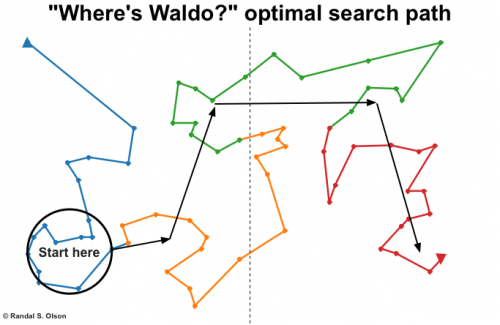February 9, 2015 weblog
Path-finder computes search strategy to find Waldo

London-born Where's Waldo? creator Martin Handford started out as a commercial illustrator with a specialty in drawing crowd scenes. By now we know how that talent supported his success and fame. His first book, Where's Waldo?, was published in 1987.
In a Q&A exchange, the question was posed, "How long does it take for you to draw one scene? The reply was, "It depends… sometimes up to three months." Fans who keep accepting the challenges, of course, would want to know if there were a way to find Waldo in the very detailed illustrations with so many other people populating the pages, a faster way which would take them quite less time. A researcher has taken us on his own journey to finding Waldo using what he knows about machine learning. Randy Olson, a PhD candidate in Michigan State University's Computer Science program, earlier this month posted this account: "As I found myself unexpectedly snowed in this weekend, I decided to take on a weekend project for fun….I was going to pull out every machine learning trick in my tool box to compute the optimal search strategy for finding Waldo." He was up to the challenge; he said he does data-tinkering as a hobby on weekends. He tackles new data-analysis problems, reports what's interesting in results on his blog, and also posts data visualizations on Twitter, not always created by him alone. Reynolds used what he knew in an attempt to compute the optimal search strategy for finding Waldo.
In discussing his findings, he mentioned interesting trends about page location ariwaldo-computing-the-optimal-search-strategy-for-finding-waldo/sing" target="_blank">www.randalolson.com/2015/02/03 … r-finding-waldo/sing from a "kernel density estimation" and then, he said, on to the "real fun," in selecting smarter methods for approximating the optimal search path. He spoke about genetic algorithms which "continually tinker with the solution—always trying something slightly different from the current best solution and keeping the better one—until they can't find a better solution any more." (MathWorks defined it as a way to solve problems based on a natural selection process that mimics biological evolution. "The algorithm repeatedly modifies a population of individual solutions. At each step, the genetic algorithm randomly selects individuals from the current population and uses them as parents to produce the children for the next generation. Over successive generations, the population 'evolves' toward an optimal solution.") Olson said he also tried a "hillclimber" algorithm, "but it always converged on a worse solution than the genetic algorithm."

All in all, Olson was careful to put his investigation in perspective: "We should never take results from machine learning too literally." He said. "This was all done in good humor." He also said, "As with so many things in life, the joy of finding Waldo is in the journey, not the destination."
More information: www.randalolson.com/2015/02/03 … y-for-finding-waldo/
© 2015 Tech Xplore


















